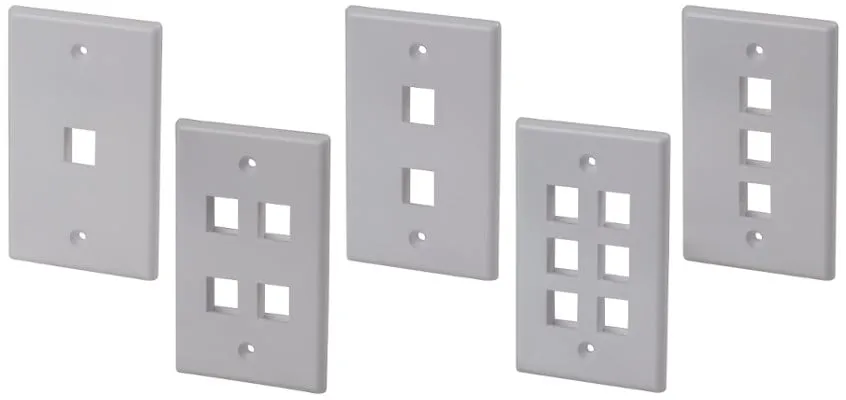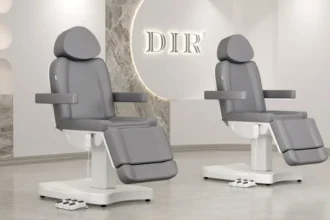In today’s fast-paced world of connectivity, keystone wall plates play an essential role in organizing and managing different types of cables, such as Ethernet, HDMI, and audio cables. A 4-port keystone wall plates CAD is one of the most commonly used types in homes and businesses, providing flexibility and functionality. This guide will explore the purpose of a 4-port keystone wall plate, its applications, benefits, and how CAD (Computer-Aided Design) plays a significant role in designing these components.
What is a 4-port keystone wall plates CAD?
A 4-port keystone wall plates CAD is a wall-mounted plate designed to hold up to four keystone jacks. These jacks are modular connectors that can accommodate a variety of cable types, including Ethernet (Cat5e, Cat6), HDMI, audio, USB, and more. By offering multiple ports, this wall plate helps maintain an organized, efficient, and tidy wiring setup, whether in a home, office, or commercial building.
Key Features of a 4-port keystone wall plates CAD
- Modular Design: The wall plate features snap-in slots for various keystone jacks, which makes it customizable to suit your cabling needs.
- Multiple Ports: A 4-port design allows users to install up to four keystone jacks in one plate, ideal for environments that require multiple data, audio, or video connections.
- Compatibility: It fits standard electrical boxes and can support a wide range of keystone jacks, providing the flexibility to upgrade or change connectors as technology evolves.
The Role of CAD in Designing 4-port keystone wall plates CAD
CAD (Computer-Aided Design) is crucial for creating detailed and accurate blueprints for a variety of products, including 4-port keystone wall plates CAD. Whether you are designing a custom wall plate or need a CAD file for a product to integrate into a larger building project, CAD ensures precision and efficiency in the design process.
Why Use CAD for Keystone Wall Plates?
- Customization: CAD allows designers to create custom designs, adjusting the plate size, port spacing, and features based on specific needs or space requirements.
- Accuracy: With CAD, manufacturers can produce products with precise dimensions, ensuring the wall plate fits perfectly with both the keystone jacks and the electrical box.
- Efficient Prototyping: CAD models enable quick and cost-effective prototyping, allowing for design revisions before production begins.
Benefits of Using a 4-port keystone wall plates CAD
The use of a 4-port keystone wall plate offers several advantages, making it a preferred choice for a variety of applications, from home networking to commercial installations.
1. Organized Cabling
One of the most significant benefits of using a 4-port keystone wall plate is its ability to help organize and manage cables. By using a single wall plate to house multiple connections, you can eliminate cable clutter and prevent tangles, ensuring a cleaner and safer environment.
2. Flexibility and Versatility
With its modular design, the 4-port keystone wall plates CAD can support different types of connectors. Whether you need Ethernet, HDMI, or audio connections, you can easily mix and match keystone jacks. This flexibility makes it an ideal solution for a variety of installations, from networking hubs to home theater systems.
3. Easy Upgrades and Maintenance
As technology evolves, the demand for faster speeds, higher quality video, or more efficient audio systems increases. Keystone jacks can easily be swapped out without replacing the entire wall plate. This upgradeability ensures that your system remains relevant for years to come.
4. Enhanced Signal Quality
A well-organized and properly installed keystone system helps prevent interference, which is especially important for high-speed data transmission. The neat and secure connections ensure the integrity of the signals, resulting in improved performance for your network or multimedia setup.
How CAD Helps in Designing the 4-port keystone wall plates CAD
When creating a 4-port keystone wall plate, certain design features need to be accounted for to ensure functionality, durability, and ease of installation. CAD software provides the tools necessary to create precise and detailed designs. Here’s how CAD contributes to the design process:
1. Precise Dimensions
CAD tools allow for the exact measurement of the plate’s dimensions, ensuring that the cutouts for the keystone jacks are appropriately sized. This precision ensures that jacks fit securely into the plate without the risk of loose connections or gaps.
2. Material Selection and Thickness
A variety of materials can be used to manufacture keystone wall plates, including plastic, metal, and custom materials. CAD allows designers to select the most appropriate material and specify the plate’s thickness based on the application and required durability.
3. Mounting Features
CAD software helps design the mounting features of the plate, such as screw holes and slots for securing the wall plate to the electrical box. These features must be precisely aligned to guarantee that the plate stays securely in place once installed.
4. Customization Options
Whether it’s incorporating additional ports, adding labeling spaces, or integrating cable management features, CAD gives the flexibility to design a custom solution tailored to specific requirements. This level of customization is especially useful in both residential and commercial projects.
How to Design a 4-port keystone wall plates CAD

Designing a 4-port keystone wall plates CAD using CAD software involves a few essential steps. Below is an overview of the process that helps ensure the final product is accurate and functional.
Step 1: Set Up the Base Plate
The first step in the CAD design process is to create the base plate. Start by drawing a rectangle with the standard dimensions (e.g., 4.5 inches by 2.75 inches) or custom dimensions based on your needs.
Step 2: Create the Keystone Jack Cutouts
Next, create four evenly spaced cutouts on the plate to accommodate the keystone jacks. These cutouts should be large enough to hold the jacks securely but not so large that the jacks can slip out of place. Be sure to measure the exact dimensions of the jacks and leave a small margin around them for a secure fit.
Step 3: Add Mounting Holes
The CAD design should include holes for mounting screws to secure the wall plate to the electrical box. Position these holes accurately in the four corners of the plate. Standard screw hole sizes (typically 4mm or 6mm in diameter) will ensure compatibility with most mounting screws.
Step 4: Choose Material and Thickness
Select the material for your wall plate (e.g., plastic or metal) and specify the thickness of the plate. This will depend on factors like durability requirements and the type of environment in which the plate will be used.
Step 5: Incorporate Additional Features
If needed, include additional design elements like cable management features, ventilation holes, or spaces for labeling. You can also incorporate custom logos, text, or engraving if you plan to personalize the plates.
Step 6: Finalize and Export the CAD Model
After completing the design, finalize it by double-checking the dimensions and features. Once you’re satisfied with the design, export the CAD model into an appropriate file format (e.g., DXF, STL, or DWG) that can be used for manufacturing.
Also Read: Boat Tie Down Straps 72 Inches Long
Applications of 4-Port Keystone Wall Plates
The versatility of a 4-port keystone wall plate makes it ideal for a wide range of applications, from home networking setups to large commercial installations.
1. Home Networking
In modern homes, a 4-port keystone wall plates CAD is perfect for organizing and managing the cables that connect various devices, such as routers, switches, and smart home devices. It offers a centralized point for network connectivity, ensuring tidy and efficient cable management.
2. Home Theater Systems
For home theater setups, keystone wall plates can house HDMI, audio, and video connections. A 4-port design allows for multiple connections to be made from a single wall plate, providing an elegant solution for home entertainment systems.
3. Commercial Offices
In commercial spaces, particularly in office environments, a 4-port keystone wall plate allows employees to easily connect to the network, phone lines, or audio systems. The ability to customize the jacks according to specific needs makes this wall plate ideal for businesses requiring efficient connectivity.
4. Educational and Conference Rooms
Keystone wall plates are also used in educational settings and conference rooms. The ability to integrate various types of connectors (such as HDMI for presentations or Ethernet for internet access) makes the 4-port keystone wall plate a versatile solution for modern classrooms and meeting rooms.
Conclusion
The 4-port keystone wall plates CAD is a vital component in modern wiring and connectivity setups, offering both flexibility and efficiency. With the help of CAD software, the design and production of these wall plates can be customized to meet specific needs, whether it’s for home networking, home theater installations, or commercial applications. The ability to create precise, modular designs through CAD ensures that the wall plate is both functional and adaptable to future upgrades. Whether you’re designing a custom setup or choosing a pre-made solution, the 4-port keystone wall plate remains an essential part of modern connectivity infrastructure.



